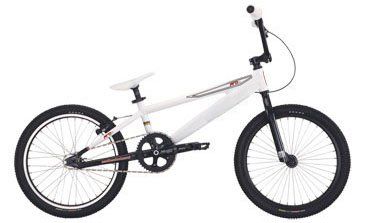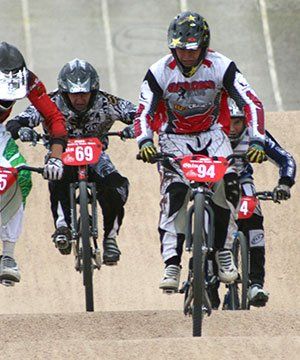BMX: Race
Which Racing BMX is right for me? This can sometimes be a very hard question to answer. Here at Marshall's Cycles, we can help you choose a bike that will suit your racing needs.
We have put together this information on the different types of Race BMXs available on the market today. Yes! It can all be very confusing…If you need any questions answered you can send us an email, call on (03) 5278 3839 or simply drop into the store for a chat.
For more information on BMX racing visit the
Geelong BMX Club's website…
BMX History
BMX started in the early 1970s when children began racing their bicycles on dirt tracks in southern California, drawing inspiration from the motocross superstars of the time. The size and availability of the Schwinn Sting-Ray made it the natural bike of choice, since they were easily customized for better handling and performance. BMX racing was a phenomenon by the mid-1970s. Children were racing standard road bikes off-road, around purpose-built tracks in [California].
The 1972 motorcycle racing documentary On Any Sunday is generally credited with inspiring the movement nationally in the US; its opening scene shows kids riding their Schwinn Stingrays off-road. By the middle of that decade the sport achieved critical mass, and manufacturers began creating bicycles designed especially for the sport.
George E. Esser founded the National Bicycle League as a non-profit bicycle motocross sanctioning organization in 1974. Before they set up the NBL, George and his wife, Mary, sanctioned motorcycle races with the AMA (American Motocross Association). Their two sons, Greg and Brian, raced motorcycles, but also enjoyed riding and racing BMX with their friends. It was their sons' interest, and there being no BMX organizations in the East, that prompted George to start the NBL in Florida.
By 1977, the American Bicycle Association (ABA) was organized as a national sanctioning body for the growing sport. In April 1981, the International BMX Federation was founded, and the first world championships were held in 1982. Since January 1993 BMX has been integrated into the Union Cycliste Internationale.
In the late 1970s BMX Racing started in Australia, where Geelong had their first BMX club in the early 1980s.
The sport of Bicycle Motocross - Freestyle BMX is now one of the staple events at the annual Summer X Games Extreme Sports competition, held largely on both coasts of the United States. The popularity of the sport has increased due to its relative ease and availability of places to ride and do tricks.
In 2003, the International Olympic Committee made BMX racing a full medal Olympic sport for 2008 Summer Olympic Games in Beijing, China, and Maris Stromberg's (male, for Latvia) and Anne-Caroline Chanson (female, for France) were crowned the first Olympic champions.
BMX 20"

BMX 24" Cruiser

BMX Racing
BMX racing is a type of off-road bicycle racing. The format of BMX was derived from motocross racing. BMX bicycle races are sprint races on purpose-built off-road single lap racetracks. The track usually consists of a starting gate for up to eight racers, a groomed, serpentine, dirt racecourse made of various jumps and rollers and a finish line.
The course is usually flat, about 6m-8m wide and has large, banked corners that help the riders maintain speed. The sport of BMX racing is facilitated by several regional and international sanctioning bodies. They provide rules for governing the conduct of the races, specify age group and skill-level classifications among the racers, and maintain points-accumulation system over the racing season. The sport is very family oriented and largely participant-driven, with riders ranging in age from 3 to 60, and over. Professional ranks exist for both men and women, where the age ranges from 15 to 40 years.
A BMX "Class" bike is a strong, quick-handling, lightweight derivative of the standard 20-inch (510 mm)-wheel, single-speed youth bicycle, made from Aluminium or carbon fibre. Variations include a larger 24-inch (610 mm)-wheel "cruiser" class. Cruisers were originally made for adults who couldn't fit the 20-inch (510 mm)-wheel bikes, but now is raced by all age groups.
While BMX racing is an individual sport, teams are often formed from racers in different classifications for camaraderie and often for business exposure of a sponsoring organization or company. BMX racing rewards strength, quickness, and bike handling. Many successful BMX racers have gone on to leverage their skills in other forms of bicycle and motorcycle competitions.
BMX racing became a medal sport at the 2008 Summer Olympics in Beijing under the UCI sanctioning body.






